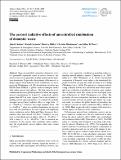The aerosol radiative effects of uncontrolled combustion of domestic waste
Author(s)
Kodros, John K.; Cucinotta, Rachel; Wiedinmyer, Christine; Pierce, Jeffrey R.; Ridley, David Andrew
DownloadKodros-2016-The aerosol radiativ.pdf (3.846Mb)
PUBLISHER_CC
Publisher with Creative Commons License
Creative Commons Attribution
Terms of use
Metadata
Show full item recordAbstract
Open, uncontrolled combustion of domestic waste is a potentially significant source of aerosol; however, this aerosol source is not generally included in many global emissions inventories. To provide a first estimate of the aerosol radiative impacts from domestic-waste combustion, we incorporate the Wiedinmyer et al. (2014) emissions inventory into GEOS-Chem-TOMAS, a global chemical-transport model with online aerosol microphysics. We find domestic-waste combustion increases global-mean black carbon and organic aerosol concentrations by 8 and 6 %, respectively, and by greater than 40 % in some regions. Due to uncertainties regarding aerosol optical properties, we estimate the globally averaged aerosol direct radiative effect to range from −5 to −20 mW m[superscript −2]; however, this range increases from −40 to +4 mW m[superscript −2] when we consider uncertainties in emission mass and size distribution. In some regions with significant waste combustion, such as India and China, the aerosol direct radiative effect may exceed −0.4 W m[superscript −2]. Similarly, we estimate a cloud-albedo aerosol indirect effect of −13 mW m[superscript −2], with a range of −4 to −49 mW m[superscript −2] due to emission uncertainties. In the regions with significant waste combustion, the cloud-albedo aerosol indirect effect may exceed −0.4 W m[superscript −2].
Date issued
2016-06Department
Massachusetts Institute of Technology. Department of Civil and Environmental EngineeringJournal
Atmospheric Chemistry and Physics
Publisher
Copernicus GmbH
Citation
Kodros, John K., Rachel Cucinotta, David A. Ridley, Christine Wiedinmyer, and Jeffrey R. Pierce. “The Aerosol Radiative Effects of Uncontrolled Combustion of Domestic Waste.” Atmospheric Chemistry and Physics, vol. 16, no. 11, 2016, pp. 6771–6784.
Version: Final published version
ISSN
1680-7324
1680-7316